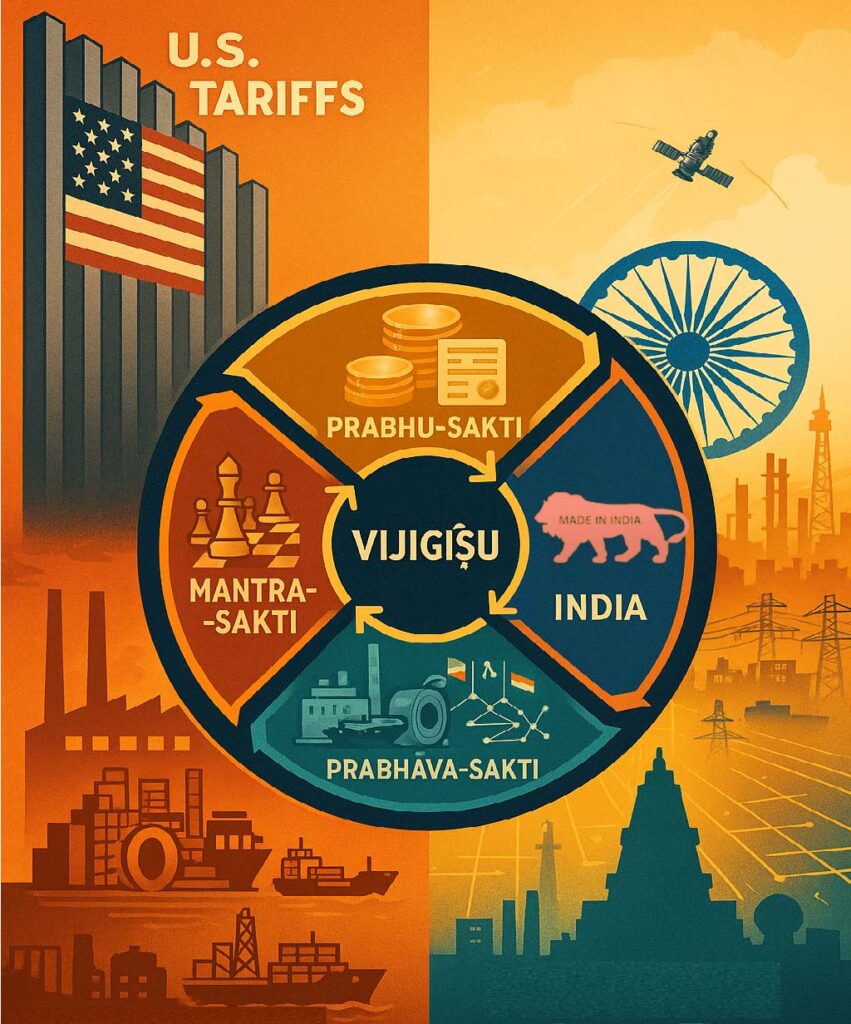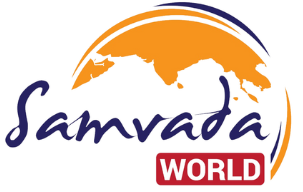
- If 1991 was about opening up, 2025 should be about building up: using external pressure to accelerate internal transformation.
- Tariffs are a price signal to localise complexity: Every new tariff line on Indian exports should trigger a mirror ‘localize-the-bottleneck’ sprint inside India.
- The state’s first response should be to strengthen Prabhu-śakti by expanding credit guarantees and interest support for MSMEs and mid-cap exporters in tariff-hit sectors.
- Mantra-śakti is not PR; it is statecraft; Prabhāva-śakti is built by hands, not just by headlines; The vijigīṣu builds concentric rings of autonomy, not isolation.
India’s latest trade skirmish with the United States is being portrayed as a crisis. It is better understood as a hinge moment—an opportunity on the scale of 1991 to rewire the economy for resilience, technological depth, and jobs-led growth. If 1991 was about opening up, 2025 should be about building up: using external pressure to accelerate internal transformation. Kautilya gives us the grammar for this task. Power (śakti) has three strands—Prabhu-śakti (sovereign/financial power), Prabhāva-śakti (material and military-industrial capacity), and Mantra-śakti (the power of counsel, strategy, and intelligence). And his maṇḍala theory urges the vijigīṣu—the aspiring leader—to knit coalitions, balance rivals, and pursue yogakṣema: the twin goals of security and welfare. Guided by Nīti (policy prudence) and Viveka (discernment), India can turn a tariff war into a national capability sprint.
The Reality Check—And The Opening
Start with the numbers. The United States remains India’s top partner across goods and services. In 2024, total U.S.–India trade (goods + services) was about $212.3 billion: $128.9 billion in goods, and $83.4 billion in services. U.S. goods exports to India were $41.5 billion; imports from India were $87.3 billion, leaving the U.S. with a $45.8 billion goods deficit. Services trade is near balance: U.S. services exports to India were $41.8 billion and imports $41.6 billion in 2024. This year’s escalation—50% Section 232 tariffs on steel and aluminium for most countries, with additional expansions to derivative products—directly hits supply chains where Indian firms are climbing the value ladder. Some reporting also points to broader, India-specific tariff measures tied to energy and defence choices. However one reads Washington’s evolving posture, the policy signal is unambiguous: the era of frictionless globalisation is over. For the vijigīṣu, that is not a cause for complaint; it is a cue to act.
Prabhu-Śakti: Fortify The Sovereign Balance Sheet And Lower The Cost Of Capital
A tariff war raises financing costs and squeezes margins. The state’s first response should be to strengthen Prabhu-śakti: Expand and target credit guarantees and interest subventions to MSMEs and mid-cap exporters in tariff-exposed sectors—metals, machinery parts, auto components, chemicals, textiles, electronics sub-assemblies—on a strict “produce, export, and deepen domestic value-add” covenant. Achieve single-window port clearance and a predictable “green channel” for repeat exporters; push Dedicated Freight Corridors to full utility; and use the PM Gati Shakti framework to shave 150–200 bps off logistics cost-to-GDP over the next 24 months. Every percentage point cut is an across-the-board tariff offset. Lock in a five-year “no-surprises” regime for indirect tax and export rebates (RoDTEP/RoSCTL) for firms meeting value-add thresholds. Policy predictability is sovereign power; it lowers the risk premium more than any subsidy. Where U.S. tariffs create choke points (e.g., speciality steels), use rupee trade settlement and long-tenor sovereign-backed lines with trusted partners to ensure continuity while domestic capacity ramps.
Prabhāva-Śakti: Build The Factories Of The Future—Fast
The second arc of śakti is material capability. Tariffs are a price signal to localize complexity: Every new tariff line on Indian exports should trigger a mirror “localize-the-bottleneck” sprint inside India: map the top five imported inputs for that line, announce a time-bound PLI micro-scheme (two years, not five), and fund consortia of MSMEs + labs to indigenize process recipes, tooling, and testing. The KPI is not just output—it’s the domestic content ratio and mean time to qualify. If 50% Section 232 barriers are the new normal, our counter is metallurgical depth: speciality steels (electrical, tool, and automotive grades), low-carbon DRI, high-strength aluminium and copper alloys, and recycling at scale. A cluster approach—steel + auto + capital goods + R&D—in eastern and central India can create “materials to machines” corridors that permanently raise India’s Prabhāva-śakti. Treat power semiconductors (SiC/GaN), motors, drives, and industrial controls as a national mission. They are the skeleton of modern manufacturing—from EVs to CNC machines. Every gigawatt of domestic motor/drive capacity reduces import vulnerability and creates exportables immune to fashion cycles. Leverage iDEX, Make-1/2, and the positive indigenisation lists to pull dual-use tech (sensors, composites, propellants, optics) into civilian supply chains. Defence is a forge for process discipline; the civilian economy gains when those standards spill over. Move rapidly to Indian standards that mirror the frontier (IEC/ISO) and require local testing/certification capacity within 6–12 months. When firms can qualify at home, the learning curve steepens, and export cycles shorten.
Mantra-Śakti: Strategy, Intelligence, And Coalition Design
Mantra-śakti is not PR; it is statecraft. In a maṇḍala world, every state is a potential ally, rival, or neutral—and changes category by the issue. Even amid tariffs, the U.S. is India’s most consequential technology and services partner. The services ledger is nearly balanced—and growing. Keep digital trade, services mobility, standards cooperation, and co-development of frontier tech insulated from tariff turbulence through bespoke “issue mini-laterals” (India–U.S.–EU on trusted AI chips; India–U.S.–Japan on maritime MRO; India–U.S.–UAE on green shipping). Retaliate where it is credible, proportionate, and capacity-building—for example, tariff-rate quotas on products where domestic substitutes exist or incentivising supply shifts to India-friendly sources. Where retaliation hurts our own downstream sectors, use smart offset policies instead of blunt tariffs. Deepen trade facilitation and market access with Southeast Asia, the Gulf, Africa, and Latin America to hedge U.S. volatility: FTAs tailored to rules-of-origin rigour, mutual recognition of standards, and logistics corridors (IMEC-like, but with near-term bankable legs). The vijigīṣu builds concentric rings of autonomy, not isolation. India’s message—at the WTO, G20 working groups, or Track 1.5—must be steady: our objective is security and welfare for 1.4 billion, powered by clean growth and fair trade. We seek contest, not conflict; competition, not coercion.
Kautilya gives us the grammar for this task. Power (śakti) has three strands — Prabhu-śakti (sovereign/financial power), Prabhāva-śakti (material and military-industrial capacity), and Mantra-śakti (the power of counsel, strategy, and intelligence).
Five Hard Pivots To Seize The Moment
(1) Services-plus manufacturing. India’s services trade with the U.S. is already a pillar; make “services-embedded manufacturing” our edge. Export a robot plus its lifetime software; a turbine plus remote monitoring; a car part plus predictive maintenance. This bundles intangible value that is less tariff-sensitive.
(2) Export insurance at startup speed. Expand ECGC products for MSMEs with instant, digital underwriting for small-ticket shipments. Tariff turbulence raises counterparty risk; cheap, reliable insurance unlocks risk-taking.
(3) Skills as infrastructure. A national network of “Technician & Tooling Institutes” aligned to the top 200 export HS codes—moulding, die-making, precision welding, NDT, mechatronics—would do more for export competitiveness than any single-tax tweak. Prabhāva-śakti is built by hands, not just by headlines.
(4) Energy hedging. Keep energy imports diversified and predictable—crude, LNG, and critical minerals—through long-term contracts and joint ventures. Every energy shock shows up as an export cost shock three quarters later. Hedge now; export better later.
(5) Bureaucracy as a comparative advantage. Make trade facilitation a civil-service OKR: time-to-remission, time-to-refund, time-to-test, time-to-clear. If India becomes the world’s fastest place to try, we’ll soon be the best place to build.
The Kautilyan Frame For 2047
Kautilya’s vijigīṣu does not chase prestige; he accumulates options. That is the spirit in which to approach tariffs: each barrier abroad becomes a trigger to remove a barrier at home. Each shock is a nudge to deepen capex, codify standards, and cluster R&D with production. Vidura’s Nīti reminds us that dharma is the compass: policy must privilege honest enterprise, fair competition, and the welfare of the many—yogakṣema in practice, not as a slogan. The next five years should be India’s plan to silently move forward. India should move from assembly to architecture in key sectors—power electronics, industrial machinery, speciality materials—shrinking import dependence and raising the domestic value-add ratio by 10–15 percentage points. MSMEs plug into global supply chains not as jobbers but as co-designers; service revenues wrap around manufactured exports, muting tariff exposure. Logistics costs should fall decisively; customs becomes a partner in competitiveness; testing labs proliferate; the “cost of uncertainty” collapses. The U.S.–India corridor matures, paradoxically, through friction: goods face rough weather, but services, investment, standards, and co-innovation deepen—because both sides see strategic returns that tariffs can’t tax.
A Note On Leverage—And Humility
It is tempting to answer tariff with tariff. Sometimes we must. But long-run leverage does not come from mirror punishment; it comes from productivity. The United States will continue to be a critical market and technology partner. Its 2024 data show a goods deficit with India, yes, but also a near-balanced services account and a growing overall relationship. That tells us where to play offence and where to hold our fire. Where American policy overreaches, India should respond with Nīti and Viveka: surgical, rules-consistent measures; a door always open to carve-outs that preserve mutual strengths; and relentless domestic reforms that make us tariff-proof.
As Kautilya might counsel, the wise king uses the enemy’s blows to harden his steel. Viksit Bharat 2047 is not a pledge pinned to a date; it is a staircase of compounding capability. A tariff war can be the first step up, if we choose to climb. Prabhu-śakti will lower the cost of capital and of uncertainty. Prabhāva-śakti will turn clusters into engines and materials into machines. Mantra-śakti will keep our coalitions supple, our retaliation smart, and our narrative steady. The maṇḍala is not a static map; it is a dance floor. The vijigīṣu leads by setting the tempo. P. V. Narasimha Rao used a crisis to unlock Indian enterprise. We can use this one to anchor it—deeper skills, broader supply chains, faster standards, stronger firms. Do this consistently, and tariffs become noise. The signal is an India that builds from within, trades with confidence, and pursues yogakṣema—security and welfare—on the dharma path, for millions of young Indians whose aspirations will define the republic. If we treat this moment with Kautilya’s realism and Vidura’s ethics, a “tariff war” will read, in hindsight, as the year India decided to become truly tariff-proof—and unmistakably world-class.
P. V. Narasimha Rao used a crisis to unlock Indian enterprise. We can use this one to anchor it—deeper skills, broader supply chains, faster standards, stronger firms.
Dr. Nanda Kishor M. S. is an Associate Professor at the Department of Politics and International Studies, Pondicherry University, and former Head of Geopolitics and International Relations at Manipal University. His expertise spans India’s foreign policy, conflict resolution, international law, and national security, with several publications and fellowships from institutions including UNHCR, Brookings, and DAAD. The views expressed are the author’s own.
